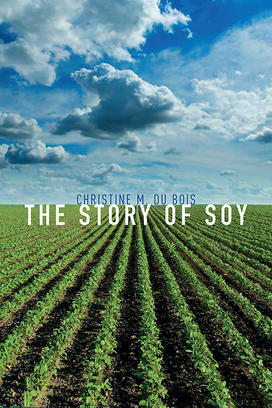Christine M. Du Bois ’84 on the Small Soy Plant’s Global Impact

The book: Soybeans are one of the most versatile crops on the planet. Their oil is widely for food and industrial purposes, and their packed-in protein fuels the diets of not only humans but much of the world’s livestock as well.
In The Story of Soy (Reaktion Books), Christine M. Du Bois ’84 details how the soybean plant’s versatility has given the plant and those who control it remarkable power. Throughout history soybeans have catalyzed conflict, shaped economies, and affected people in the developing world. They have been a source of dietary breakthroughs and global health concerns. Stories and data from the time of soy’s domestication to the present underscore the plant’s influence on trade and society.
The author: Christine M. Du Bois ’84 is a former research director of the Johns Hopkins Project on Soybeans. She is a co-author and editor of The World of Soy and lives in Pennsylvania.
Opening lines: In 1904 two grand imperial powers locked into unspeakably violent combat over control of a single small, steep hill. At stake was power over a strategic land rich in timber, coal, wheat — and soy. Soldiers atop ‘203 Meter Hill’ had a crucial vantage point for domination of lucrative Port Arthur. They rained machine-gun, rifle and artillery fire down on their enemies, who in response shot lethal mortar fire upwards. The attacking army doggedly persisted, sending thousands of men struggling upwards to kill and themselves rapidly be slain — ‘human bullets’ they were called. The losses on both sides were great; in little more than two months, some 20,000 soldiers perished. In the end, the attacking Japanese triumphed over their Russian adversaries, wresting control of 203 Meter Hill, Port Arthur and, ultimately, prized Manchuria in northeast China, with its copious harvests of soybeans.
Soy provided an incentive for conflict as well as food for the Japanese army, fodder for Russian horses and oil to make soap for both armies. The Russo-Japanese war of 1904-5 also saw many new technologies in combat, including barbed wire, the self-powered machine gun and mines. Massive steel warships battled spectacularly at sea, making critical use of early radio communications. The two armies’ clash at the inland city of Mukden in 1905, for which more than half a million men were mobilized, was perhaps the largest battle of modern times to that point — the Battle of Leipzig in 1813 in the Napoleonic era being the only other contender for that bloody distinction.
Its scale and modernity have led some historians to consider the Russo-Japanese War a ‘dress rehearsal’ for the First World War. Because of the conflict’s impact on balances of power, some have even referred to this struggle for economic control of Manchuria as ‘World War Zero’. Its after-effects proved far-reaching and varied. In Japan, cheap soy protein became more available to the population, while Japanese traders in Manchuria became rich from commerce in soy. Japanese dependence on soy in their diets would, over time, spur them to purchase it on a massive scale from the United States and Brazil. In the immediate aftermath of the war, Japan grew more imperialistic. Meanwhile in Russia, domestic disgust with the czarist government’s war performance catalyzed the Revolution of 1905, which in turn fomented conditions for the 1917 Communist Revolution. Simultaneously, seeing Russia’s weakness, Germany was militarily emboldened. Elsewhere, activists in colonies around the world took inspiration from a non-Western people’s defeat of a major European power.
This war, over strategic territorial control, over trade in raw materials, and specifically over soy, is often neglected. In this way, the war is like the bean itself: shaping our world in multiple ways, while largely hidden or ignored. Yet, as this book will show, soy’s importance to human diets and the world economy has only increased since the Russo-Japanese War.
Reviews: “The Story of Soy places soy, nutrition, and the near future into a global picture. ... Soy just goes on getting more and more important. This book is needed.” – Sidney Mintz, author of Sweetness and Power












No responses yet